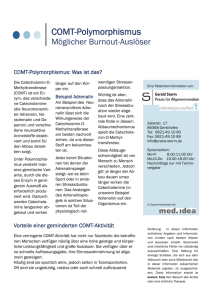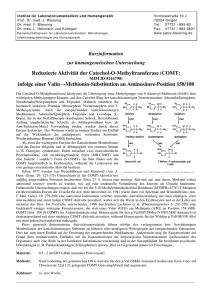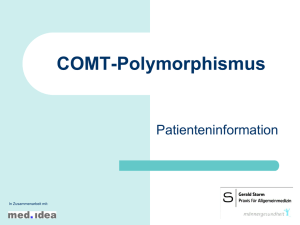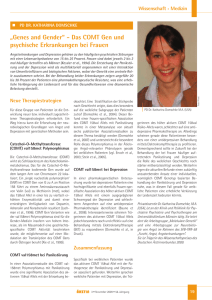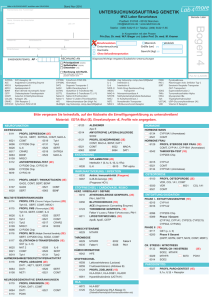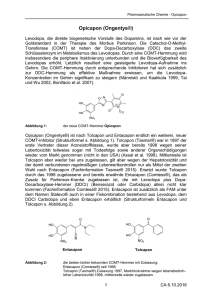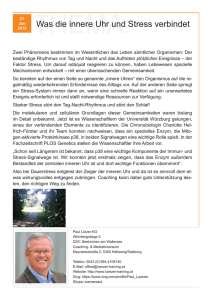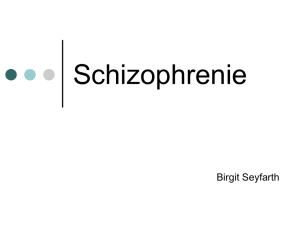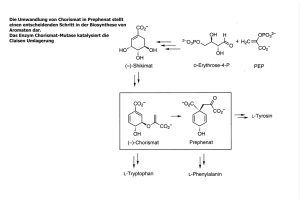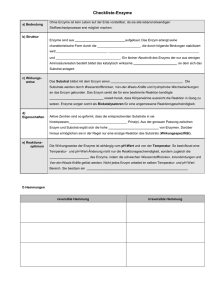dspace cover page - ETH E
Werbung
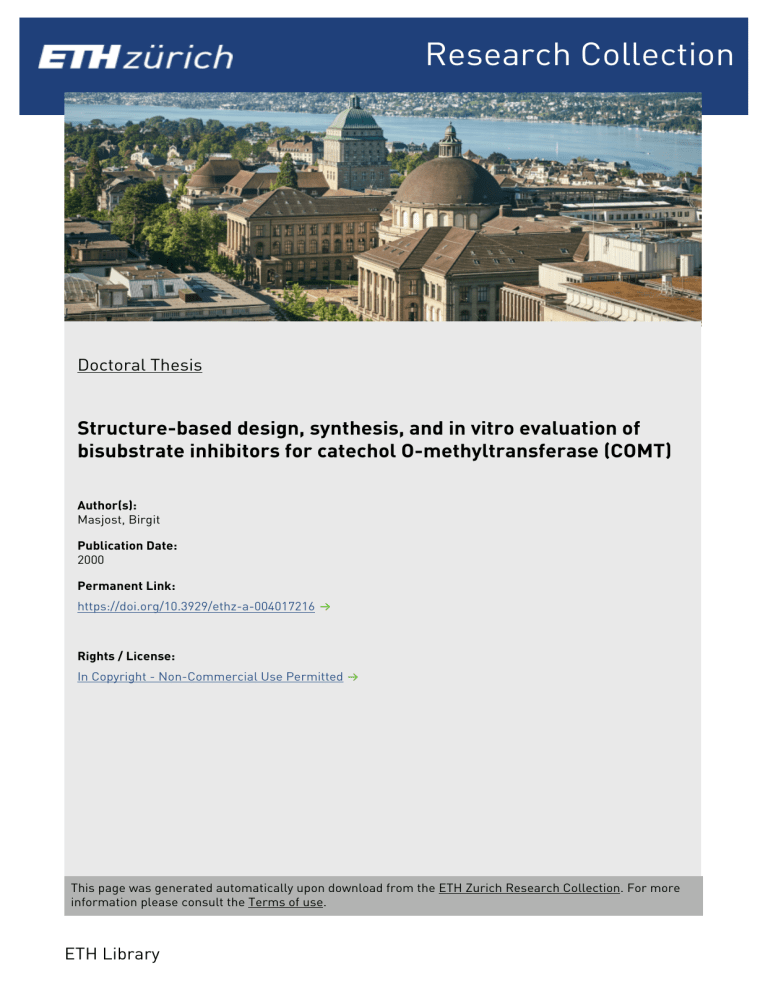
Research Collection Doctoral Thesis Structure-based design, synthesis, and in vitro evaluation of bisubstrate inhibitors for catechol O-methyltransferase (COMT) Author(s): Masjost, Birgit Publication Date: 2000 Permanent Link: https://doi.org/10.3929/ethz-a-004017216 Rights / License: In Copyright - Non-Commercial Use Permitted This page was generated automatically upon download from the ETH Zurich Research Collection. For more information please consult the Terms of use. ETH Library Diss. ETH No. 13719 STRUCTURE-BASED DESIGN, SYNTHESIS, AND IN VITRO EVALUATION O:F BISUBSTRATE INIIIBITORS FOR CATECHOL O-METHYLTRANSFERASE (COMT) A dissertation submitted to the SWISS FEDERAL INSTITUTE OF TECHNOLOGY ZURICH for the degree of DOCTOR OF NATURAL SClENCES Presented by BIRGIT MASJOST Dipl. Chem. Westfälische Wilhelms-Universität Münster born in Ahlen, Germany, October 18, 1971 accepted on the recommendation of Prof. D1'. Franccis Diederich, examiner Prof. D1'. Donald Hilvert, co-examiner 01'. Roland Jakob-Roetne, co-examiner Zurich 2000 v ABSTRACT Inhibition of the enzyme catechol O-mcthyltransferase (COMT) is an important approach for developing new therapeutic treatments for Parkinson's disease. COMT is a weIl studied enzyme. It catalyzes methyl group transfer from the cofactor S-adenosylmethionine (SAM) to the hydroxy group of catechol-type substrates such as dopamine. Its biological function in plants, animals, and human beings has been clucidated to a good extent, and the kinetics of the mechanism of methylation have been studied in detail. X-ray crystal structures have been solved for recombinant COMT in the apo form and cocrystallized with SAM, M g 2+ ions, and 3,5-dinitrocatechol. In this thesis, we designed and synthesized a new class of COMT inhibitors which are bisubstrate inhibitors according to thcir inhibition mechanism. Previously, only single-substrate analog inhibitors of COMT were known. The lead structure 7 was developed employing computer-aided structure-based design. A synthetic pathway was developed for 7 that allows facile introduction of different chemical functionalities into the molecule. A key step in the synthesis was the nucleosidation reaction für the coupling ofnatural and modified bases to the ribose moiety in a regioand stereoselective fashion. In vitro kinetic studies on the inhibitory activity of 7 were performed revealing that 7 occupies both the substrate and cofactor binding sites with K; values of O.55±0.1 !-!M and O.3±O.1 ~tM, respcctively. It exhibits cornpetitive kinetics with regard to SAM and noncompetitive kinetics with regard to catcchol substrates. For comparison, the same kinetic studies were carried out on catechol 14. It shows a competitive inhibition mechanism for the catechol binding site and uncompetitive inhibition of the COÜ1Ctor binding site as would be expected for a derivative of benzene-I ,2-diol which does not bind to tbe SAM bin ding sitc. Cocrystallization of the bisubstrate inhibitor 7 and COMT is currently underway to further clarify the exact complexation mode. ABSTRACT VI ~ HO ~ I~ f N~0l-D-J '1--( H N02 HO f tN H2 I"~ ~ Ho~JN/"",,/OMe yH K10 2 OH 14 7 IC so (without preincubation) =4 [1M ICso (with preincubation) =2 [1M ICso (without preincubation) =26 pM ICso (with preincubation) =25 [1M N-Succinimidyl 2,3-dihydroxy-5-nitrobenzoate 8, aprecursor in the synthesis of 7 exhibited a surprisingly high inhibitory activity. Therefore, its inhibition mechanism was determined and found to be competitive with the substrate for an incubation time of one minute with COMT and noncompetitive with the substrate after 15 min preincubation of 8 with the enzyme. Such an inhibition mechanism was observed with tight-binding inhibitors like Tolcapone (Tasmarß'), which is a pharmaceutical used in the therapy of Parkinson's disease. In this respect, the Nsuccinimidyl functionality in 8 seems to be a good replacement for the ortho nitro group in catecholic inhibitors combined with an electron-withdrawing group in para position. If stable analogs of 8 exhibited the same inhibitory activity, these compounds could be interesting follow-ups for To1capone. H~O~ Y 0 N02 8 IC so (without preincubation) =106 nM Tolcapone (Tasmar ®); ICso =36 nM Structural variations were introduced into lead 7 to determine how much each chemical functionality contributes to its binding affinity for COMT, and to investigate different subunits for the binding sites, which were designed by molecular modeling, in order to enhance the inhibitory potency of the lead. We synthesized and tested two molecules (69 and 70), containing pyrimidine bases, with regard to their binding in the base pocket. These molecules were more than 100-fold less active than the lead 7. The molecules 107, I08, and 109 with alkanediyl and 3azaalkanediyl chains between adenine and catechol rather than ribose which is a subunit of 7 were synthesized to study the structural influence of the ribose and its function as a H-bond donor. Compounds 107, 108, and l09were found to be 25-50 ABSTRACT Vll times less active than the lead. To investigate whether the catechol moiety in the lead 7 coordinates to the Mg 2+ ion, compound 88, which does not contain a nitro group on the catechol moiety, was synthesized. It exhibited a more than IOO-fold decrease in inhibitory activity, confinning that the lead does bind to the M g2+ ion. In order to study the influence of the length of the connecting bridge between ribose and catechol, molecule 117 was synthesized, which lacks one oxygen atom between ribose and catechol as eompared to 7, and found to be about six times more potent than the original lead. Inhibitor 117 exhibits a more rigid scaffold than the lead preventing a collapse ofthe aromatic side chains, which is favorable for binding to the enzyme in terms of entropy. NOE conformational studies on 7,69, and 117 in solution revealed that in all three molecules the bases have the anti-conformation which is favorable for binding to the base pocket. In compound 69 a hydrophobic collapse of the two terminal chromophores is observed and reorganizational energy is required for binding, which accounts for the decrease in binding affinity of 69 compared to 7 and 117. In vitro assays were carried out on all compounds, and kinetic studies were performed to gain insight into the inhibition mechanisms and structure-activity relationships. V HO I ~ .r::: tH; N~O,\=?N~ H N02 0 69 HO OH ICso (without preincubation) = 522 ~tM lLt' V HO I ~ HN~O\=?'~~ 0 X 107 CH2 108 NH 109 NH a 1 1 2 55 ~IM 77 f.IM 86 ~IM .r::: N0 2 HO OH 70 ICso (without preincubation) > 100 ~IM ~~H2 N0 2 ~ HO I ~ OH 0 tJt.:Y N~~N H ~O N 117 HO OH ICso (without preincubation) =600 nM 88 ICso (without preincubation) > 100 !IM Vlll ZUSAMMENFASSUNG Inhibitoren des Enzyms Catechol-Cz-methyltransferase (COMI') werden als Pharmazeutika gegen die parkinsonsche Krankheit eingesetzt. COMT katalysiert den Methylgruppentransfer von dem Kofaktor SAdenosylmethionin (SAM) auf die Hydroxygruppe catecholischer Substrate wie z.B. Dopamin, Die biologische Bedeutung des in Pflanzen, Tieren und Menschen vorkommenden Enzyms sowie der Mechanismus der Methylierungsreaktion sind gut erforscht. Die Kristallstrukturen der Apoform des Enzyms und kokristallisiert mit SAM, M g 2+ Ionen und 3,5-Dinitrocatechol von rekombinantem COMT sind bekannt. In dieser Arbeit beschreiben wir den Entwurf und die Synthese von neuartigen Inhibitoren von COMT, welche nach ihrem Bindungsmechanismus an das Enzym als Bisubstratinhibitoren bezeichnet werden können. Die bekannten, im nanomolaren Bereich an das Enzym bindenden Inhibitoren sind Catecholanaloge. Die Leitstruktur 7 wurde mit Hilfe von Computer-gestütztem, stukturbasierten Design gefunden. Der für 7 ausgearbeitete Syntheseweg ermöglicht es, auch andere chemische Funktionalitäten in das Molekül einzuführen. Ein Schlüsse1schritt in der Synthese war die Nukleosidierungsreaktion, mit der verschiedene natürliche und modifizierte Basen regio- und stereoselektiv mit der Riboseuntereinheit verknüpft wurden. In vitro durchgeführte kinetische Studien mit der Verbindung 7 zeigten, dass diese die Substrat- und die Kofaktorbindestelle im Enzym besetzt, wobei K, Werte von O.55±O.1 ftM, bzw. O.3±O.1 ~lM gemessen wurden. Im Vergleich dazu ergab sich in analogen Kinetikexperimenten mit der catecholischen Vergleichsverbindung 14, dass diese kompetitiv zum Substrat an die catecholische Bindetasche bindet und unkompetitiv zum Kofaktor SAM ist. Dieses Ergebnis entspricht den Erwartungen für eine substratanaloge, catecholische Verbindung, die nicht in Kofaktorbindetasche bindet. die Um zusätzliche Informationen über die genauen Wechselwirkungen zwischen 7 und den Aminosäuren im aktiven Zentrum von COMT zu erhalten, werden derzeit Versuche zur Kokristallisation der Verbindung mit rekombinantem COMT unternommen, ZUSAMMENFASSUNG ~ H I ~ ~ ]X t:8 N~~N- N H -D N02 HO OH 7 ICso (ohne Präinkubation) =4 ~lM ICso (mit Präinkubation) =2 pM HoAJN~oMe ~H N0 2 14 ICso (ohne Präinkubation) =26 ~lM ICso (mit Präinkubation) 25 pM = Der 2,3-Dihydroxy-5-nitrobenzoesäure-N-succinimidylester (S), eine Vorstufe in der Synthese von 7, zeigte überraschend eine Inhibitionswirkung im nanomolaren Bereich. Bei der Bestimmung des Inhibitionsmechanismus fanden wir, dass S COMT kompetitiv zum Substrat hemmt bei einer Inkubationszeit von einer Minute mit dem Enzym. Dagegen ist die Hemmung nichtkompetitiv zum Substrat, wenn Enzym und Inhibitor 15 min zusammen vorinkubiert werden. Ein solches kinetisches Verhalten wurde bei hochaffinen Inhibitoren wie z.B. Tolcapone (Tasmar'v) gefunden, welches bereits als Medikament in der Parkinsontherapie am Menschen eingesetzt wird. In diesem Zusammenhang könnte die N-Succinimidylester-Funktionalität ein Ersatz für die Nitrogruppe in catecholischen Inhibitoren sein, wenn sich in para Position ein elektronenziehender Substituent befindet, und stabile Analoge von S könnten interessante Leitstrukturen für Nachfolger von Tolcapone werden. ~ HO ~ I~ t-\ y ° O/N N0 2 8 ICso (ohne Präinkubation) =106 nM Tolcapone (Tasmar ®); ICso =36 nM Im folgenden wurden Strukturvarianten der Leitstruktur 7 synthetisiert, um abschätzen zu können, wieviel jeder einzelne Teil der Verbindung zur Inhibitorstärke beiträgt und um einen Einblick zu bekommen, welche anderen Struktureinheiten in die jeweiligen Bindetaschen passen, um so die Aktivität der Leitstruktur zu verbessern. Es wurden zwei Moleküle 69 und 70 synthetisiert, welche Pyrimidinbasen enthalten. Diese Moleküle waren 100 mal weniger aktiv als die Leitstruktur 7. Die Verbindungen I07, lOS und 109, die Alkandiyl- und 3-Azaalkandiylketten zwischen Adenin und Ribose enthalten, wurden synthetisiert, um den strukturellen Einfluss der Ribose und ihre Bedeutung als Wasserstoftbrückenbildner im Hemmer 7 zu x ZUSAMMENFASSUNG untersuchen. In den entsprechenden Enzymtests zeigte sich, dass 107, 108 und 109 25-50 mal schwächere Inhibitoren sind als 7. Um herauszufinden, ob die catecholische Untereinheit von 7 im aktiven Zentrum von COMT mit den Hydroxygruppen an das M g 2+ Ion bindet, wurde das analoge Molekül 88 ohne Nitrogruppe synthetisiert, welches eine IOO-fach niedrigere Aktivität hatte als 7. Dieses Ergebnis ist ein starker Hinweis dafür, dass die Leitstruktur 7 in die catecholische Bindetasche von COMT bindet. Um den Eint1uss der "Brückenlänge" für das Verbindungsstück zwischen Ribose und Catechol zu studieren, haben wir die Verbindung 117 synthetisiert, die wegen des fehlenden Sauerstoffs eine im Vergleich zu 7 kürzere Brücke hat. Wie sich in den Enzymtests zeigte, ist 117 sechs mal aktiver als die Leitstruktur 7. Wegen der kürzeren Brückenlänge verliert 117 konformationelle Freiheitsgrade gegenüber 7, weil das Zusammenfalten der aromatischen Seitenarme verhindert wird, d.h. bei der Bindung an das Enzym ist der Entropieverlust geringer. Die Verbindungen 7,69 und 117 wurden mit Hilfe von NOE spektroskopischen Untersuchungen auf ihre Konformation in Lösung untersucht. In allen drei Molekülen ist die Base in der richtigen anti Orientierung (anti bzg1. der Ribose), um in die Basentasche zu binden entsprechend den "Modelling" Voraussagen. Beim Molekül 69 wurde ein hydrophober Kollaps gefunden, d.h. ein Zusammenfalten der aromatischen Seitenarme, so dass der freie Zustand des Moleküls stabilisiert ist und zusätzlich Energie aufgewandt werden muss, um das Molekül in eine für die Bindung an das Enzym günstige Konformation zu bringen, welches ein Grund für die geringe Affinität dieser Verbindung zum Enzym sein könnte verglichen mit 7 und 117. Mit allen Verbindungen wurden in vitro Enzymtests durchgeführt und zum Teil wurde die Inhibitionskinetik bestimmt, um mehr über den Inhibitionsmechanismus und die Struktur-Aktivitäts-Beziehungen für Bisubstratinhibitoren des Typs 7 zu erfahren. ZUSAMMENFASSUNG ~ HO I ~ ~ Xl ci N~O\=?N H N02 0 69 HO ICso (ohne Präinkubation) 0 OH X =522 ~tM 1:: ~~~ 2 HO~~N~Oq~ I ~ H a 107 CH 2 1 108 NH 1 109 NH 2 55 ~tM 77 ~tM 86 [1M 0 0 N02 HO OH 70 ICso (ohne Präinkubation) > 100 flM ~2 f=d H HO~N~ OH 0 ~ O \-( N OH OH 117 ICso (ohne Präinkubation) =600 nM 88 1Cso (ohne Präinkubation) > 100 ~tM
